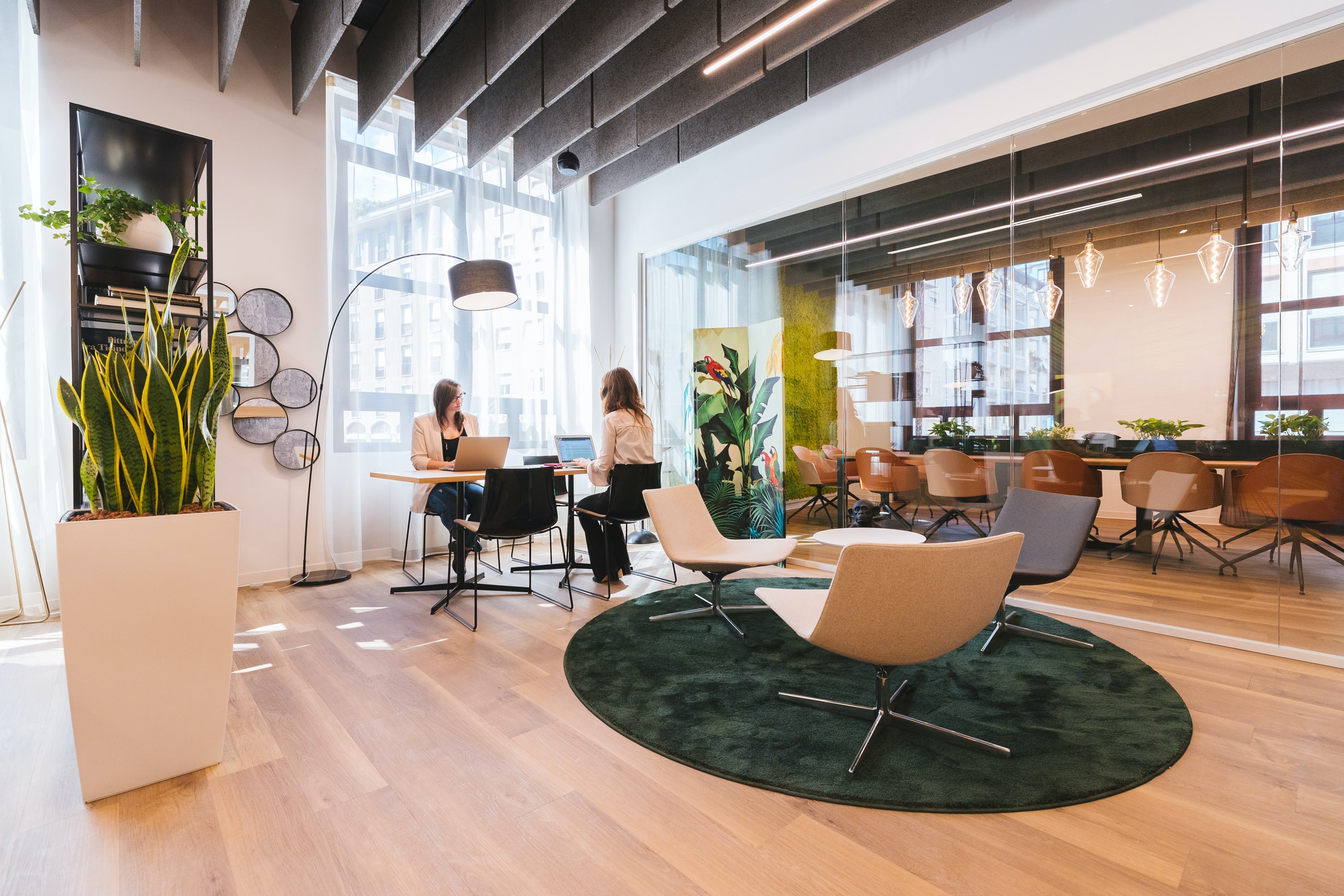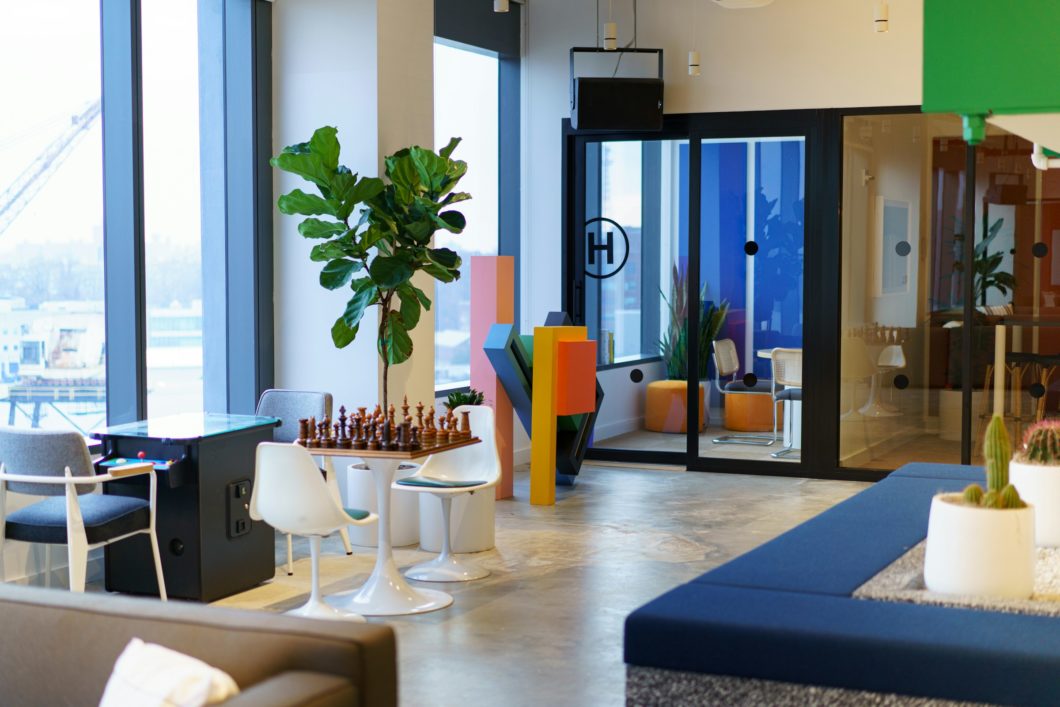Coworking spaces will prioritise sustainability, design, amenities, and work/life balance to become the ultimate flexible workspace.
By Making Moves London
June 12, 2023
Imagine this: Monday morning, you walk into the office greeted by a room full of adorable puppies (they’re all in the in-house doggy daycare, obviously). You then sit at your desk doing what you do best, consuming the unlimited fresh filter coffee on offer.
Before you know it, it’s lunchtime and you realise you’ve not had a chance to get your hair cut – no problem, just pop down to the on-site hairdresser. 4pm soon rolls around (we finish early because it’s Monday, and who needs an extra-long one of those) and you’re happily chatting away with your colleagues near the free prosecco/beer tap. Okay. This might not be the norm, but you get the gist.
Coworking is fast becoming the ideal solution for businesses. The traditional ways of working are no longer suited to the way we want to live, and coworking spaces are quickly providing the freedom and room to expand.
We can see the future of coworking spaces including a number of exciting developments, such as eco-friendly design solutions, more facilities to help with a work-life blend, and continuing design innovation to create the best workplace possible.
Take a look at our predictions below to give you a glimpse into what we believe is the future of flexible office space.
While coworking spaces have boomed in popularity since 2015, it was the pandemic that really put remote working in the spotlight.
As many businesses and entire industries which previously had never offered remote working have done so since COVID-19 closed the world’s offices, coworking spaces have become more popular than ever. Time in the office, even for two or three days a week is now seen as a premium time that might come at the cost of lower productivity compared to working from home. Coworking spaces meanwhile, offer a creative place to work, network, and the change in scenery can invigorate staff tired of home or office working.
There’s been an alignment with hospitality which was always there but accelerated post-COVID. Coffee shops that offer dedicated working spaces, for example, or pub chain Brewdog, which has since 2019 opened its bars as working spaces during off-peak times.
In many office and coworking spaces, this looks like making a workspace a ‘destination’ — with all of the benefits and comforts from home, whether that’s ergonomic setups, facilities for pets, personal items, free food, and more.
As businesses invest in their spaces — whether headquarters or satellite coworking spaces, they become more of a point of staff engagement and a real point of attraction. Once the office workforce had a taste of working from home, a drab office cubicle five days a week was suddenly a less attractive proposition…
Coworking spaces, meanwhile, have always been strong in this space. As these spaces evolve, expect them to take amenities offered, flexibility of spaces, and modern conveniences to the next level. If the return to work is seen as a luxury for workers, coworking spaces are going to become even more dramatic and special, to tempt workers from their homes.

Sustainability and eco-consciousness will be a high priority for office providers, as research shows that the majority of workers want their workplace to improve its sustainability policy.
Serviced office providers are already taking steps to create eco-friendly buildings. The Office Group prioritised sustainability when they created the White Collar Factory, naming it a ‘workplace of the future’ because of its green credentials. The design of the building structure encourages natural heating and ventilation, while its digital connectivity allows important energy data to be collected and analysed.
Coworking has a unique advantage over some traditional offices in terms of generally being a greener solution thanks to its shared nature. Recognising sustainability as a key issue for customers, coworking spaces have started to build sustainability into their core, even becoming community-focused spaces that contribute to their location, whether that’s local products, services, or suppliers. Coworking spaces and B-Corps go hand in hand, and some even exclusively offer space to businesses that have shared values. This trend won’t slow down, as workers and businesses alike look to make better eco-friendly decisions.
In need of a little inspiration for your own space? Check out our latest tips for green office ideas.
Understanding the needs of the worker will be key to coworking office design in the future.
Biophilic designs, breakout areas, quiet zones and outdoor spaces are all design features that will be considered. Office providers may use heat mapping to understand which areas are most effectively used in existing buildings, and use this information in the design of new ones.
Whether it’s creative ways to utilise space, office designs which are more accessible (no staircases, emergency exits, corridor sizing), or entirely unique spins on the working format – how does working on a boat, climbing wall, or beach sound? Yes, these are all real coworking spaces!
As fully flexible and remote work continues to thrive in some industries, expect to see coworking spaces pop up in the most unusual and innovative of spaces.
Coworking used to be the reserve of smaller businesses, startups, and sole traders looking to get a business off the ground.
But since the pandemic, coworking spaces have been increasingly utilised by larger companies, either looking to adapt to a changing requirement for office floor space given flexible working. 30% of Microsoft’s NYC base has access to coworking space in the city, for example, while Jaguar Land Rover has long been a proponent of the benefits of allowing its 30,000 UK employees to work from shared offices.
This approach can prove more cost-effective than leasing a ‘’full capacity’ office space that’s often half-full when many staff are working from home. Employees benefit from the variety of choosing a working space where they feel most effective on any given day.
As larger companies adopt coworking spaces of their own, or offer memberships to outsourced spaces like WeWork, expect them to become even more commonplace, more mainstream, and more desirable to workers.
Technology and coworking go hand-in-hand, and the adoption of remote tech is higher than ever.
While we might not be at the point of working in the ‘ultimate’ coworking space, the Metaverse just yet, the advent of remote working tech over the pandemic has meant that the availability of coworking spaces to the public is as high as it’s ever been thanks to increased collaboration through online conferencing and similar tools..
While Apple’s Vision Pro is touted to advance the field of virtual meetings in a way Metaverse has been unable to, coworking spaces of the future might look like a mix of offline and online worlds using augmented and mixed reality in much more effective ways than the current technology of 2024 allows.
Entire software industries to facilitate this have been around for years, and systems will continue to evolve to become more effective and efficient. Booking systems, collaborative means of working, and cloud computing are all beneficiaries of the needs of users of coworking spaces.
We couldn’t mention coworking without talking about WeWork. Since its inception in 2008, it’s (controversially) glamorised the concept of coworking and helped fuel the industry.
With the positioning of coworking now a little more glamorous and aspirational for startups and scaleups, the office has become more of an experiential space. Coworking spaces are now expected to have top-tier facilities, help individuals build a personal and professional network, and introduce the ideas of a blended work/life balance.
WeWork took the outdated views of coworking and brought them into modern times. They’ve set a benchmark for what customers expect when it comes to coworking spaces, and will likely continue to lead the way into the future.
For more on the coworking behemoth, read ‘What is WeWork & Why is it a Game-Changer?’
As prices rise in London and other cities across the UK, more people are opting to live in the commuter belt and travel to work. However, travel can take up a massive part of the day, limiting our actual working hours or cutting into our relaxation time.
Popularised in London and necessitated by rising house prices, areas like Reading and St. Albans have become popular as towns to live in but still allow a relatively easy commute to London.
Morgan Stanley reports a mere 18% of European office workers are wanting to return to an office five days a week, so the idea of “living anywhere within a cathedral” and working remotely or from a nearby coworking space is unlikely to go away.
It has been suggested that we might expect to see more coworking buildings opening up in the suburbs so that people can work remotely without having to work with all the distractions of being at home.
This allows people spread over disparate areas the benefits of a head office, without needing to be physically near one. New coworking spaces can, therefore, emerge in more cost-effective commuter towns and have instant access to a large community of workers.
This allows businesses wider access to talent, less commuting and stress for workers, the flexibility of having access to a head office when all-team meetings are required, and though challenges remain around true hybrid working, coworking spaces in this sense continue to grow in popularity.
As coworking spaces become even less like offices of the past and more like sociable hubs where work happens to take place, expect this trend to progress even further.
The notion of the office as a ‘social anchor’ has long been touted, and the importance of face-to-face meeting spaces, and spaces to encourage freeform collaboration is more important than ever as remote and hybrid working becomes more commonplace.
It’s almost cliche, but coworking spaces are no longer just for work, they can also act as a place to eat, socialise, exercise, look after children and even sleep. In the future, they may function more like leisure hotels, with sections for working and sections for living.
Many restaurants and bars are also rebranding as coworking areas, like The Hoxton Hotel in Southwark which announced that it was becoming a coworking space. Meanwhile, Village Hotel Group in the UK touts coworking spaces as a core USP, providing short and long-term hotdesking, and discounts on hotel gyms, food, drink, and rooms.
As modern life becomes ever more about convenience, coworking spaces of the future could include convenience supermarkets, medical facilities, banking, and other high street staples that would be so much more convenient if they could be taken care of without leaving the workplace.
The main priority in coworking office design will be flexibility. People will want different options and access to the facilities that will help them.
Whether this is a dog-friendly office space, one that offers childcare, or one that stays open for longer than traditional hours, people need options to make their work collaborate with the other aspects of their life.
Coworking spaces are expected to be used by 5m people in 2024, with WFH fatigue and increased desire for flexibility being a key driver for this.
A recent survey by Flexa found that 89% felt better after joining a coworking space, with a key factor being that coworking helped defeat loneliness and isolation (suffered by 44% when WFH).
As the workforce ages, it’s something that’s likely to become more common. 62% of millennials have used a coworking space, and as Gen Z enters the workforce, expect an even greater increase in the demand for flexibility.
One business already embracing the coworking future is Multiverse – a fast-growing edtech company redefining how young people access training and careers. We recently helped them secure a new 16,000 sq ft headquarters at WeWork’s Eastbourne Terrace in Paddington, a move that reflects many of the trends shaping coworking in 2024.
By choosing a serviced coworking hub, Multiverse gained access to modern, flexible workspaces designed to foster collaboration, boost employee wellbeing, and support future expansion – all while staying centrally located. The space aligns perfectly with the needs of a growing, tech-driven team that values agility, community, and a dynamic work environment.
It’s a great example of how coworking spaces aren’t just for startups anymore – they’re becoming the go-to option for forward-thinking companies ready to scale.
To see more examples of our recent projects, browse our selection of case studies here.
Coworking has been on the rise over the past decade and shows no signs of slowing down. With spaces becoming more premium, more innovative, more plentiful, and more desired, it’s a growing market that will genuinely compete with the corporate office for the attention of amenity-hungry employees looking for a workspace that’ll engage and excite.
Making Moves can help you find the ideal coworking or serviced office for your busines. To find out more, make an enquiry here

? Source, negotiate and manage entire office moves.
? Dispose, sublet or redesign your office.
?️ Professional, independent support.